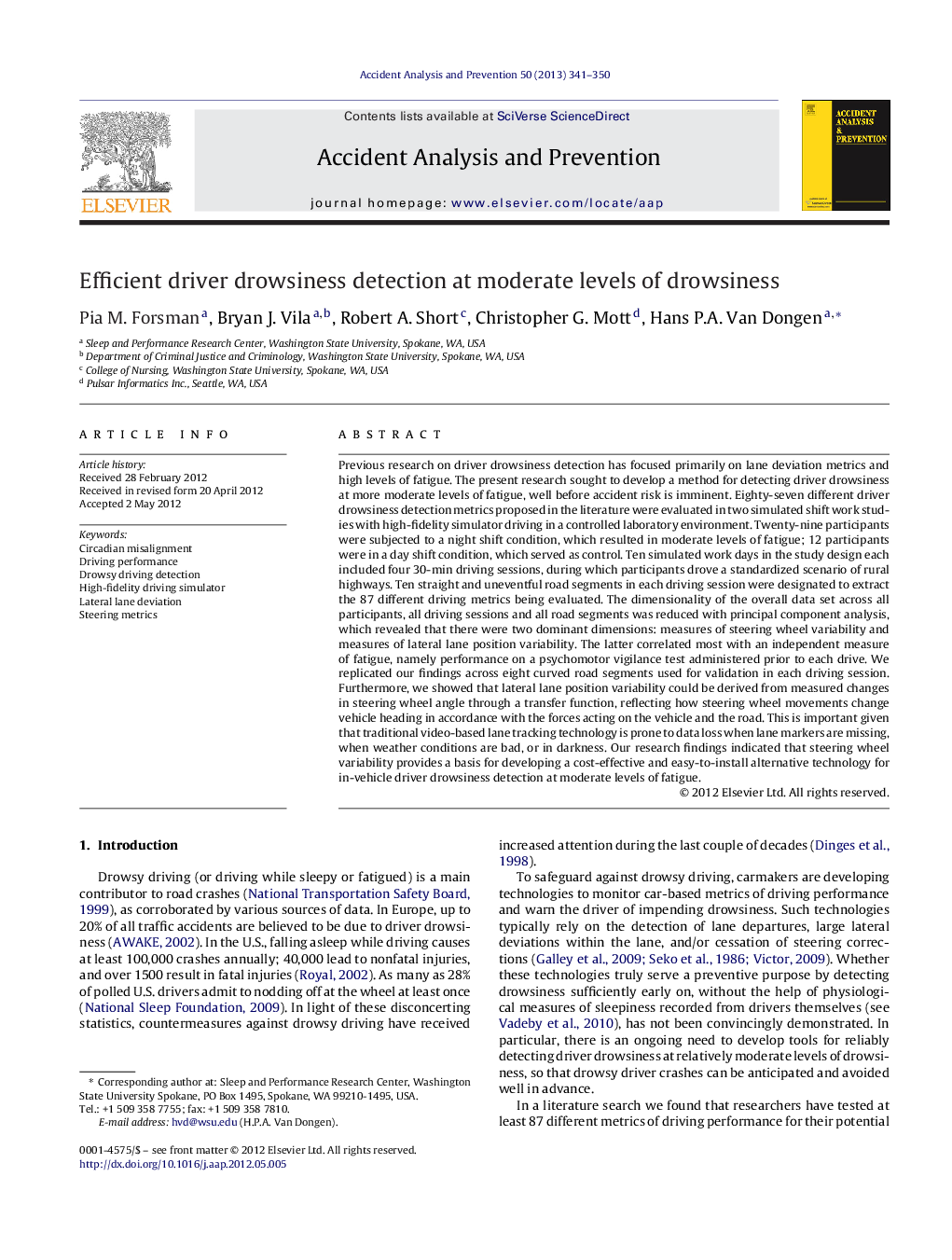| کد مقاله | کد نشریه | سال انتشار | مقاله انگلیسی | نسخه تمام متن |
|---|---|---|---|---|
| 6966831 | 1452947 | 2013 | 10 صفحه PDF | دانلود رایگان |
عنوان انگلیسی مقاله ISI
Efficient driver drowsiness detection at moderate levels of drowsiness
ترجمه فارسی عنوان
تشخیص خواب آلودگی رانندگی کارآمد در سطح متوسط خواب آلودگی
دانلود مقاله + سفارش ترجمه
دانلود مقاله ISI انگلیسی
رایگان برای ایرانیان
کلمات کلیدی
ناهماهنگی دورانی عملکرد رانندگی، تشخیص رانندگی مرسوم، شبیه ساز رانندگی با وفاداری بالا، انحراف خطوط جانبی، معیارهای فرماندهی
ترجمه چکیده
تحقیقات قبلی در مورد تشخیص خواب آلودگی راننده در درجه اول بر معیارهای انحراف خط و سطوح خستگی بالا متمرکز شده است. پژوهش حاضر با هدف توسعه یک روش برای تشخیص خواب آلودگی راننده در سطح متوسطی از خستگی، قبل از حادثه خطرناک است. هشتاد و هفت معیارهای تشخیص خواب آلودگی راننده در ادبیات پیشنهاد شده در دو مطالعه شبیه سازی شده شغل با شبیه ساز رانندگی با وفاداری بالا در محیط آزمایشگاهی مورد بررسی قرار گرفتند. 29 نفر شرکت کننده تحت شرایط تغییر شیب قرار گرفتند که منجر به خستگی متوسط شد. 12 شرکت کننده در یک حالت تغییر روز قرار داشتند که به عنوان کنترل کنترل می شد. ده روز شبیه سازی شده در طراحی مطالعه شامل چهار جلسه رانندگی 30 دقیقه ای بود که طی آن شرکت کنندگان یک سناریوی استاندارد از بزرگراه های روستایی را اجرا کردند. در هر جلسه رانندگی ده بخش مستقیم و غیرمستقیم به منظور استخراج 87 معیار رانندگی مختلف مورد ارزیابی قرار گرفت. ابعاد کلی داده ها در میان تمام شرکت کنندگان، تمام جلسات رانندگی و تمام بخش های جاده با استفاده از تجزیه و تحلیل مولفه اصلی کاهش یافت، که نشان داد که دو ابعاد غالب وجود دارد: اندازه گیری متغیر فرمان چرخ و اندازه گیری متغیر موقعیت لبه جانبی. این دومین رابطه را با یک اندازه گیری خستگی مستقل، یعنی عملکرد بر روی یک آزمون روانشناختی هوشیاری که قبل از هر درایو انجام می شود، مرتبط می کند. ما یافته های ما در هشت بخش منحنی جاده مورد استفاده برای اعتبار سنجی در هر جلسه رانندگی تکرار شد. علاوه بر این، ما نشان دادیم که تغیرات موقعیت لبه جانبی می تواند از تغییرات اندازه گیری شده در زاویه چرخ فرمان از طریق یک تابع انتقال حاصل شود، که منعکس کننده چگونگی حرکت چرخ های رانندگی به عنوان وسیله نقلیه مطابق با نیروها بر روی وسیله نقلیه و جاده می شود. این مهم است به این دلیل که تکنولوژی ردیابی خطوط سنتی مبتنی بر ویدئو مستلزم از دست دادن داده ها است هنگامی که خطوط نشانگر خطا از بین می رود، زمانی که شرایط آب و هوایی بد است یا در تاریکی. یافته های تحقیق ما نشان می دهد که متغیر فرمان چرخ، مبنایی برای ایجاد یک تکنولوژی جایگزین با هزینه و کارآیی آسان برای تشخیص خواب آلودگی رانندگی در خودرو در سطح متوسط خستگی است.
موضوعات مرتبط
مهندسی و علوم پایه
مهندسی شیمی
بهداشت و امنیت شیمی
چکیده انگلیسی
Previous research on driver drowsiness detection has focused primarily on lane deviation metrics and high levels of fatigue. The present research sought to develop a method for detecting driver drowsiness at more moderate levels of fatigue, well before accident risk is imminent. Eighty-seven different driver drowsiness detection metrics proposed in the literature were evaluated in two simulated shift work studies with high-fidelity simulator driving in a controlled laboratory environment. Twenty-nine participants were subjected to a night shift condition, which resulted in moderate levels of fatigue; 12 participants were in a day shift condition, which served as control. Ten simulated work days in the study design each included four 30-min driving sessions, during which participants drove a standardized scenario of rural highways. Ten straight and uneventful road segments in each driving session were designated to extract the 87 different driving metrics being evaluated. The dimensionality of the overall data set across all participants, all driving sessions and all road segments was reduced with principal component analysis, which revealed that there were two dominant dimensions: measures of steering wheel variability and measures of lateral lane position variability. The latter correlated most with an independent measure of fatigue, namely performance on a psychomotor vigilance test administered prior to each drive. We replicated our findings across eight curved road segments used for validation in each driving session. Furthermore, we showed that lateral lane position variability could be derived from measured changes in steering wheel angle through a transfer function, reflecting how steering wheel movements change vehicle heading in accordance with the forces acting on the vehicle and the road. This is important given that traditional video-based lane tracking technology is prone to data loss when lane markers are missing, when weather conditions are bad, or in darkness. Our research findings indicated that steering wheel variability provides a basis for developing a cost-effective and easy-to-install alternative technology for in-vehicle driver drowsiness detection at moderate levels of fatigue.
ناشر
Database: Elsevier - ScienceDirect (ساینس دایرکت)
Journal: Accident Analysis & Prevention - Volume 50, January 2013, Pages 341-350
Journal: Accident Analysis & Prevention - Volume 50, January 2013, Pages 341-350
نویسندگان
Pia M. Forsman, Bryan J. Vila, Robert A. Short, Christopher G. Mott, Hans P.A. Van Dongen,
